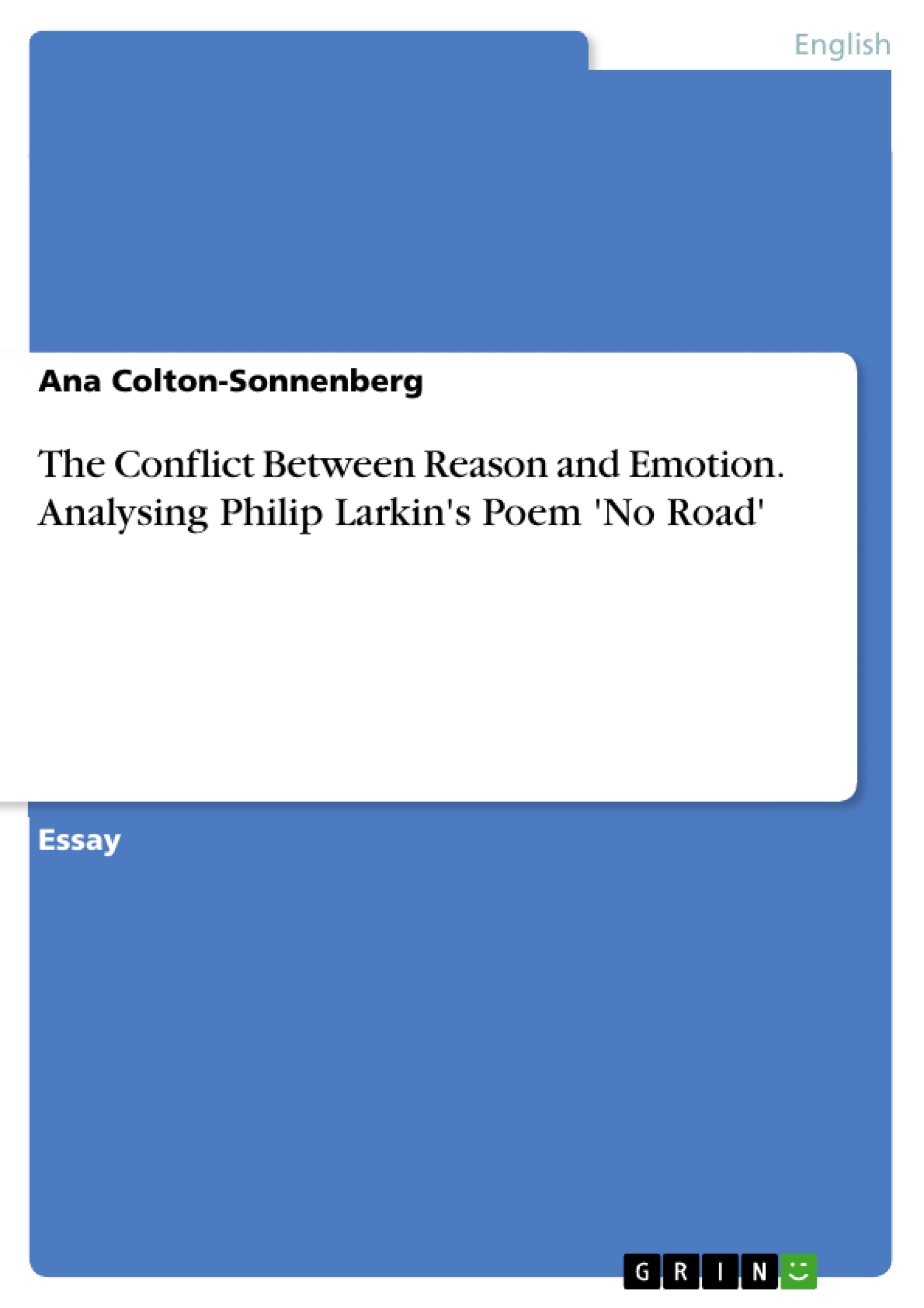The title of Philip Larkin’s “No Road” already introduces the reader to the gloomy atmosphere prevailing in the poem. In it, the persona reflects the process of letting-go of his former partner after the mutually agreed end of their relationship. Despite the strong feelings that both partners still seem to have for each other, it is not possible for them to stay together. What the poem is essentially about is the eternal human conflict between ratio and emotion. Central to this topic is the suffering caused by this antagonism. The principle devices used to communicate the theme of suffering in the poem are the narrative framework and the language. The latter is full of imagery, simile, alliteration, enjambment, and litotes. How these devices work in the communication will be discussed in the following.
The title of Philip Larkin’s “No Road” already introduces the reader to the gloomy atmosphere prevailing in the poem. In it, the persona reflects the process of letting-go of his former partner after the mutually agreed end of their relationship. Despite the strong feelings that both partners still seem to have for each other, it is not possible for them to stay together. What the poem is essentially about is the eternal human conflict between ratio and emotion. Central to this topic is the suffering caused by this antagonism. The principle devices used to communicate the theme of suffering in the poem are the narrative framework and the language. The latter is full of imagery, simile, alliteration, enjambment, and litotes. How these devices work in the communication will be discussed in the following.
Instead of presenting the subject matter in a direct, factual way, the author of the poem has chosen to embed it in a narrative framework. He introduces the reader to the topic by projecting his subjective state of mind into a persona. It is the latter that tells the story of a failed relationship thus appearing to be infused with the author’s emotion.
This is made obvious by the use of personal pronouns like “we” and “us” occurring already in the first line. By dealing with a topic common to most people, the persona not only attracts the reader’s attention but also evokes his empathy. Without this feeling, the author would not be able to communicate the emotion of suffering, as it would be a purely intellectual and associative idea. What makes the reader understand and appreciate the subject matter conveyed in the poem is his capacity to experience another’s feelings. If the reader did not develop this empathy in the course of the poem, he is almost forced to do so in the last three lines. Here, the triple repetition of the pronoun “my” deeply stirs the reader, making him see the persona’s degree of affectedness. In other words, the narrative could be seen as an objective correlative of the universal subject of suffering caused by the conflict between ratio and emotion. The persona’s feelings symbolize the emotion the author wants to express, thus evoking an emotional response in the reader. Without the narrative, the poem would simply be an enumeration of facts that do not necessarily affect the reader. In this way, then, it is the narrative framework that immerses the reader into the subject matter.
The language used in the poem is full of imagery. This mostly negative imagery serves the purpose of making the reader perceive the atmosphere of the poem through association with commonly known things and situations. It evolves around the metaphor of a road which stands for the bond that used to connect the lovers. This metaphor appears already in the title and is referred to in every stanza. As the title “No Road” already suggests, the connection between the persona and his former partner has broken down. Having ended their commitment in mutual agreement, they have gone separate ways. The author stresses the finality of this decision by using the metaphoric image “bricked our gates up” (l.2). This image of deterioration stands for the shutting down of any possibilities of communication, which is again stressed by the image of the creation of a natural barrier between the former lovers (“planted trees to screen us” l.2). The picture created especially by the first picture is a very sad and desolate one. Whenever entrances are sealed, it means that there is no hope for recovery. Bricking up doors is the final action when a building is being closed down permanently.
- Arbeit zitieren
- Ana Colton-Sonnenberg (Autor:in), 2006, The Conflict Between Reason and Emotion. Analysing Philip Larkin's Poem 'No Road', München, GRIN Verlag, https://www.grin.com/document/71208
-

-

-

-
Laden Sie Ihre eigenen Arbeiten hoch! Geld verdienen und iPhone X gewinnen. -

-
Laden Sie Ihre eigenen Arbeiten hoch! Geld verdienen und iPhone X gewinnen. -

-
Laden Sie Ihre eigenen Arbeiten hoch! Geld verdienen und iPhone X gewinnen. -

-
Laden Sie Ihre eigenen Arbeiten hoch! Geld verdienen und iPhone X gewinnen.

